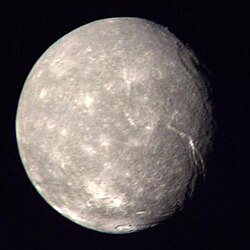Titania (moon)
 | |||||||
| Discovery | |||||||
|---|---|---|---|---|---|---|---|
| Discovered by | William Herschel | ||||||
| Discovered in | January 11, 1787 | ||||||
| Orbital characteristics | |||||||
| Semi-major axis | 435,910 km | ||||||
| Mean radius | 436,300 km | ||||||
| Eccentricity | 0.0011 | ||||||
| Orbital period | 8.706 d | ||||||
| Inclination | 0.340° (to Uranus' equator) | ||||||
| Is a moon of | Uranus | ||||||
| Physical characteristics | |||||||
| Mean diameter | 1577.8 km
(0.1237 Earths) | ||||||
| Surface area | 7,820,000 km² | ||||||
| Volume | 2,057,000,000 km³ | ||||||
| Mass | 3.526×1021 kg
(5.9×10−4 Earths) | ||||||
| Mean density | 1.72 g/cm³ | ||||||
| Surface gravity | 0.378 m/s2 (~0.039 g) | ||||||
| Escape velocity | 0.77 km/s | ||||||
| Rotation period | synchronous | ||||||
| Axial tilt | zero | ||||||
| Albedo | 0.27 | ||||||
| Apparent magnitude | 13.73 | ||||||
| Surface temp. |
| ||||||
| Atmospheric pressure | |||||||
Titania is the largest moon of Uranus and the eighth largest moon in the Solar System.
Discovery
Titania was found on 11 January 1787 by William Herschel. He reported it and Oberon the same year.[1] He later reported four more moons, which turned out to be spurious.[2]
Name and pronunciation
The names of Titania and the other four moons of Uranus then known were suggested by Herschel's son John Herschel in 1852 at the request of William Lassell. Lassell had found Ariel and Umbriel the year before.[3] He had supported Herschel's 1847 naming scheme for the seven then-known moons of Saturn and had named his newly-found eighth moon Hyperion in 1848, in accordance with Herschel's naming scheme.
All of the moons of Uranus are named for characters from Shakespeare or Alexander Pope. Titania was named after Titania, the Queen of the Faeries in A Midsummer Night's Dream. It is also designated Uranus III.
Physical characteristics
So far the only close-up images of Titania are from the Voyager 2 probe, which photographed the moon during its Uranus flyby in January, 1986. At the time of the flyby the southern hemisphere of the moon was pointed towards the Sun so only it was studied.
Although what its interior is made up of is uncertain, one model suggests that Titania is made of about 50% water ice, 30% silicate rock, and 20% methane-related organic compounds.
Surface features
Surface features on Titania are named for characters from plays by William Shakespeare.[4] Chasms on Titania are called chasmata. Escarpments here are called rupes. They are named after the places where plays by Shakespeare happen. craters on Titania are named after female characters in the plays.
A major surface feature is a huge canyon that dwarfs the scale of the Grand Canyon on Earth and is in the same class as the Valles Marineris on Mars or Ithaca Chasma on Saturn's moon Tethys.
Occultation
On September 8, 2001, Titania occulted a faint star; this was a chance to both refine its diameter and ephemeris, and to detect any extant atmosphere. The data revealed no atmosphere to a surface pressure of 0.03 microbars; if it exists, it would have to be far thinner than that of Triton or Pluto.[6][7]
Titania (moon)Surface Features Media
Other websites
Notes
- ↑ Herschel, William. 1787. An account of the discovery of two satellites revolving round the Georgian planet. Philosophical Transactions of the Royal Society of London, Vol. 77, pp. 125-129; and "On George's Planet and its satellites", Philosophical Transactions of the Royal Society of London, Vol. 78, pp. 364-378, 1788.
- ↑ Herschel, William. 1798. On the discovery of four additional satellites of the Georgium Sidus; The retrograde motion of its old satellites announced; and the cause of their disappearance at certain distances from the planet explained: Philosophical Transactions of the Royal Society of London 1798. 88: 47-79.
- ↑ http://adsabs.harvard.edu//full/seri/AN.../0034//0000169.000.html Adsabs.harvard.edu Retrieved on 05-19-07
- ↑ Strobell, M.E.; Masursky, H. (1987). "New Features Named on the Moon and Uranian Satellites". Abstracts of the Lunar and Planetary Science Conference. 18: 964–65. Bibcode:1987LPI....18..964S.
- ↑ USGS/IAU. "Titania Nomenclature Table Of Contents". Gazetteer of Planetary Nomenclature. USGS Astrogeology. Retrieved 2012-02-23.
- ↑ http://www.obspm.fr/actual/nouvelle/mar02/titania.en.shtml Archived 2013-03-07 at the Wayback Machine Obspm.fr Retrieved on 05-19-07
- ↑ http://www.lesia.obspm.fr/~titania/results.html Lesia.obspm.fr Retrieved on 05-19-07


